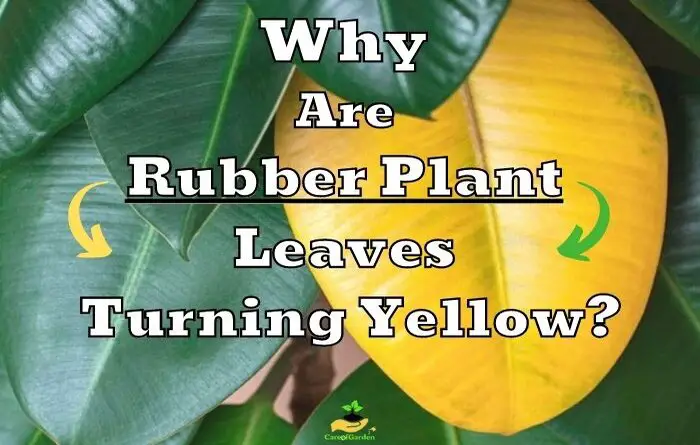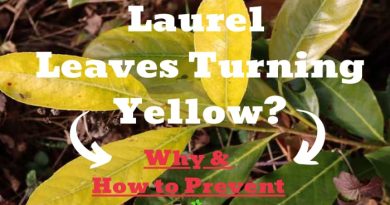Why Are Rubber Plant Leaves Turning Yellow? Find Out Now!
Today I will try to help you understand why your rubber plant leaves are turning yellow, so that you can apply correct treatments and solve the problem before it affects the rest of the foliage.
Appearance of yellow leaves on rubber plants also known as rubber fig is a sign of many reasons, including over-watering, under-watering, nutrient deficiency, or pests. Therefore, if we have not fertilized or watered enough, the plant weakens and the leaves turn yellow and fall.
| Why are Rubber Plant Leaves Turning Yellow: |
|---|
| 1. Too much or too little water |
| 2. Lack of sunlight |
| 3. Nutrient deficiency |
| 4. Incorrect soil |
| 5. Temperature changes |
| 6. Diseases |
| 7. Pests |
| 8. Wrong location |
| 9. Natural process |
1. Too much or too little water
Excess water
The main reason rubber plant leaves are turning yellow is too frequent watering, carried out without ever allowing the soil to dry well. The water stagnates inside the cavities of the soil, preventing the circulation of oxygen (essential for the roots).
Water stagnation therefore causes root asphyxia and prevents the roots from carrying out certain metabolic processes, such as the absorption of some essential nutrients.
Added to this is the risk of root rot by means of fungal pathogens that proliferate rapidly under these conditions.
A rubber tree needs a lot of water, especially in spring and summer, while it is content with a little less in autumn and winter. However, you should be careful when watering your rubber plant.
Waterlogging is considered one of the most common factors that can lead rubber plant leaves to turn yellow.
Treatment
A very effective way to control and balance the irrigation in our rubber fig is to use self-watering pots.
Instead of self watering pots, hold the pot under water for just as long, until no more air bubbles rise. Then quickly remove the pot and allow excess moisture to drain. You can then put the pot back in its place.
This method is particularly suitable for smaller rubber trees. If your rubber tree is no longer manageable enough for this procedure, it is advisable to wait until the substrate is dry to the touch before watering it, even if it has been a few weeks since the last watering.
Make sure that there is never any water left in the saucer or planter and always water moderately. Of course, the soil must not become bone dry either. Mild humidity is ideal.
Lack of water
Lack of water can also cause rubber tree leaves to turn yellow due to dehydration and an inability to absorb nutrients. Usually the first leaves to turn yellow are the lower ones, gradually progressing towards the crown if the problem is not solved.
Although the rubber plant (Ficus elastica) tolerates short periods of drought well, excessively delaying watering can cause dehydration, especially during the hot and bright months or when the ambient humidity is low. Initially, the leaves curve downwards and then begin to turn yellow and dry.
Water abundantly making sure to wet the entire soil. The yellow leaves will not turn green again, but the yellowing will quickly stop and the plant will start growing again.
Treatment
If the substrate of the rubber tree is too dry, you can dip the whole pot in water. Keep it submerged until there are no more air bubbles.
But be careful: Before you put the rubber tree back in its planter, excess water must drain off. Otherwise there will be waterlogging. This method is also suitable for normal “watering” of the rubber tree.
2. Lack of sunlight
Another of the most common reasons why the leaves of Ficus elastica turn yellow is the lack of light, especially if the plant has produced beautiful foliage in a bright place and is subsequently moved to a darker and shadier one.
In poor light conditions, the amount of photosynthesis produced by the rubber plant is insufficient to nourish all the leaves and, in order to survive it’s starts turning yellow the lower, older leaves first.
The three most common reasons for lack of sunlight are:
- The rubber plant has just been purchased, and therefore goes from a very bright greenhouse to the shade of the house.
- The rubber plant is brought home after having benefited from the bright spring or summer light.
- Natural light drops dramatically with the arrival of autumn. Therefore shorter photoperiod and lower light intensity.
Obviously the leaves can turn yellow even if we move the rubber fig too far from the window, or from a room facing south to one facing north.
Another case is that in which the least illuminated leaves turn yellow, perhaps because they are positioned lower down or hidden inside the foliage. Circumstance in which pruning may be considered.
Treatment
There can be only one recommendation here, move the Ficus elastica closer to the light. Turn on fluorescent lamps in the office and install a phytolamp if possible.
Try to always place the rubber tree in the brightest place possible, possibly where it can also benefit from a few hours of direct light a day.
Proximity to the window is essential because for every half meter of distance the intensity of indirect light drops drastically.
If like me you have the misfortune of not having good exposure consider using an LED grow light.
Even a low Wattage (24-36W) can contribute enormously if kept on for 12 hours a day, with little impact on the electricity bill.
3. Nutrient deficiency
The third cause of yellow leaves on rubber plants is a lack of nutrients or iron in the substrate. To correct it, we recommend fertilizing approximately once a month and using leaf repair treatment .
If the substrate is too low in magnesium, a pale yellowish discoloration occurs frequently on rubber plant leaves. This is due to so-called chlorosis.
Due to the lack of magnesium, the production of chlorophyll (leaf green) is reduced.
Therefore, regularly feed rubber plants. Moreover, there are a great many options for fertilizers. As an example( NPK 30-15-15 or N30-P10-K5).
From October to March apply it one time per month and after that one time in 2 weeks.
Give some liquid organic plant food every 2 weeks from spring to the end of autumn. Make sure to read the manufacturer’s instructions.
Complete fertilizers usually also contain magnesium, but are not sufficient in the case of a magnesium deficiency.
However, a special magnesium fertilizer, which is usually based on magnesium sulfate, is recommended. These mineral fertilizers are known under the name ” Epsom salt “.
4. Incorrect soil
Using a very fine substrate with high water retention such as universal soil can lead over time to having a very hard and compact block of earth. Especially after 2-3 years of growth and countless waterings.
A soil of this type limits the development of roots and tends to soak too much (or too little) with water if watered in the wrong way. To clarify this concept I must quickly explain the limits of the peat of which the universal soil is composed.
Peat has two major disadvantages:
- It is difficult to hydrate when dry (water repellent)
- It shrinks a lot when it dries
Over time, these two characteristics lead to a compact and hard substrate that absorbs little water at first glance. But that holds too much when wet well.
Furthermore, by shrinking, empty spaces are created along the edges of the vase which makes the water slide away without it being really absorbed by the clod.
Fresh potting soil is supplied with nutrition that can last a houseplant for up to 6 weeks. It is exactly indicated on the bag of the potting soil.
When you transplant a rubber plant, over-treatment with drugs, or even a too large pot that will not fit the flower, can harm it very much. Refrain from watering it immediately after transplanting.
Treatment
Repot the Ficus elastica using a softer and more airy soil, mixing sand and perlite with the universal soil. The recommended mix is about 60% potting soil, 20% sand, and 20% perlite.
If you absolutely don’t intend to pot the plant, or the time of year is wrong, make sure you water it properly.
The point is not to give the plant less water, proceeding one drop at a time at pre-set deadlines (once a week for example), but to wet it well and then let the soil dry completely.
Obviously the excess water must subsequently be removed from the saucer.
In the event that the potted soil struggles to hydrate itself, you can water it by sub-irrigation, or moisten it by pouring water and proceed with the actual watering after 10-15 minutes.
To prevent the water from flowing from the edge of the pot, you can scrape the surface of the soil with a fork to loosen it and plug the empty spaces.
5. Temperature changes
Sudden changes in temperature considerably affect the rubber plant. For this reason, when we have our rubber tree subjected to drastic changes in temperature, both cold (below 57°F) and hot, bring a strong stress, which results in yellowed leaves.
The more the variation in temperature, humidity or light (or a combination of these) is marked, the more evident the yellowing of the leaves will be.
To avoid this, we recommend locating our rubber plant in a place away from currents and heaters where it receives continuous warm temperatures.
Especially in the heating period, often dry air can be critical for the rubber tree, as foliage begins to wither, turn yellow and eventually fall off.
To avoid such situations, you should periodically measure the temperature in the room where the plant is located and take measures to ensure that it is comfortable.
This can be remedied by humidifiers or, if necessary, the leaves are sprayed daily with room-warm, lime-free water.
Drafts
The cold, understood as temperatures between 55-57°F (13-15°C) , strong downward changes in temperature or freezing air currents , bring great stress to the rubber fig causing yellow leaves and black or brown necrotic spots.
Furthermore, low temperatures slow down the plant’s metabolism, greatly reducing its need for water. The waterings should be reduced in order not to run into problems of water excess or root rottenness, which in turn cause the leaves to turn yellow.
These damages are not always immediately apparent, but tend to appear over the next few days or weeks. The more bitter the cold, the greater the consequences.
The easiest way to eliminate drafts as a problem factor, especially in the cool season, is to move the plant away from open window or door gaps.
Treatment
Keep the rubber plant in a place with night lows above 55°F (13°C) or indoors at 62-63°F (17-18°C) or more. Avoid subjecting it to drafts or cold air currents that blow directly on the plant in the winter months.
In the autumn, if you have kept the plant outside during the summer, bring it back indoors as soon as the first cold weather arrives. Unless you are lucky enough to live in particularly hot areas.
6. Diseases
Among the diseases of the leaves typical of Ficus elastica, we find fungal, bacterial or viral infections . Among these, the fungal ones are undoubtedly the most common, and also the easiest to cure.
Fungal diseases spread rapidly in humid environments with poor air circulation or when the foliage remains wet for a long time without ever drying out.
Symptoms vary depending on the specific pathogen but generally cause yellow spots within the leaf blade or on the edges of the rubber plant.
As the infection progresses, the dead tissue begins to necrotize, while a yellow halo remains where the infection is still active.
Root rot is also caused by a fungus, which proliferates and is introduced inside the roots when the soil remains soaked and they are not allowed to dry properly between waterings.
Root rot is also a fungal disease that affects the roots of the rubber fig, making them rot. No longer being able to absorb water and nutrients, the symptoms manifest themselves with yellow and brown leaves typical of nutrient deficiency and dehydration.
If you keep the rubber fig indoors, never wet the leaves before evening or during rainy days. Water only when the soil is dry.
Treatment
In the event that it is a problem limited to one or two leaves, detach them at the base or possibly cut only the infected part with sterilized scissors. Remember that the cut must be done where the tissue is still green and healthy.
If the infestation is extensive, or if it is a very small plant, a systemic fungicide must be used which has the advantage of being absorbed by the leaves and transported through the lymphatic system to the rest of the plant.
Obviously, time is needed for this to happen, if the problem is particularly serious or urgent it is better to use a cupric plant protection product which acts by contact and has immediate effect.
7. Pests
Pests, also cause rubber plant leaves to turn yellow, so take a good look at the whole plant, and if you notice them, immediately treat the plant with special preparations that you can buy at any garden store.
Many of the most common pests among houseplants such as cochineal, red spider mites (or mites), thrips or aphids also affect Ficus elastica, causing the leaves to turn yellow, mottled, pinpointed or misshapen (in the case of still growing leaves).
These insects pierce the leaves to feed on the sugars present in the processed sap. The leaves of rubber plants infested with these parasites appear yellow, discolored or dotted. As the result of photosynthesis (carbohydrates) is deprived, the plant loses its vigor and appears weakened.
Once the presence of parasites has been ascertained, the plant must be treated with specific insecticides or sprayed with oil-based products on the foliage in order to kill them by suffocation.
My advice is to use Neem oil or white oil, sprayed on the whole hair (top and bottom) two or three times 10-14 days apart.
The most common rubber fig pests are:
- Scale Insect
- Thrips
- Red spider mites
- Aphids
Red Spider Mites
If the rubber leaves start turning yellow from the edges, then most often the culprit is a spider mite. In addition to yellowing of the edges, characteristic spots appear on the leaves.
Spider mites (or mites) tend to be particularly problematic in the hot, dry months. Unfortunately, they are difficult to spot with the naked eye, especially when the infestation is in its infancy. In this case, rather than turning yellow, the leaves tend to discolor and take on a silvery gray color.
If you do not fight, the leaves die off. You will need to spray the plant with an insecticide.
If the problem is widespread on the whole plant or on several individuals, it is advisable to use white mineral oil, neem oil or potassium soap so as to suffocate them thanks to the oily patina which obstructs their respiratory system.
Thrips
Thrips are typical of the autumn period because they tend to take refuge indoors when the cold arrives. Similar to spider mites, they are difficult to detect with the naked eye. Their presence is easier to diagnose by the marks they leave on the youngest leaves.
In the case of thrips, on the other hand, it is advisable to use a neem oil-based product immediately.
Aphids and Scale Insect
Other larger insects, such as cochineals and aphids, as well as being visible to the naked eye, can be recognized by the sticky liquid (honeydew) they leave on the leaves after having sucked the sap.
In the initial stage, larger insects as cochineals and aphids can be removed manually or by spraying a solution of water and isopropyl alcohol (70/30) over the entire leaf crown.
Even a simple spraying with warm water allows you to control the infestation and prevent it from getting out of hand.
Although to have certain results each parasite should be eradicated with specific insecticides, there are generic approaches that allow you to control and defeat almost all of them.
All these treatments must be repeated after 10 days in order to eradicate any second generations and prevent the infestation from reoccurring.
8. Wrong location
Rubber plants react to the wrong place or location by turning yellow and shedding their leaves. If you moved it to an unusual place, you can return it back, but no later than 10-15 days later, otherwise additional stress is provided for the plant.
Don’t often rearrange the rubber plants from place to place. It is very difficult to adapt to new conditions (even if you move it just a meter). This is a very big stress, to which rubber plant again can react by yellowing and dropping leaves.
Unfavorable locations for rubber fig are:
- Draft
- Too little light
- Too little sun (but no direct sunlight)
- Temperatures below 53°F (15°C)
Adaptation to a new place usually takes a couple of weeks (if comfortable conditions are created there). If during this time the leaf fall has not stopped, it is better to return the rubber fig to its original place.
Treatment
It is recommended to move the plant away from open window or door. But don’t place the pot to a dark corner! Windows facing north, east or west are ideal.
The rubber plant does best in a light, warm place in the house, without direct sunlight. The variant with variegated leaves needs a little more light than the completely dark green varieties.
Rubber tree hate drafts, so choose a draft-free spot and, if possible, always leave it in this spot. To prevent it from growing to one side, you can turn it very little at a time.
9. Natural process
Rubber trees often reacts with a little leaf fall to the change of seasons (even if it grow in a warm room). In autumn and winter, rubber leaves may turn yellow without any serious reason, because this is a natural process.
Therefore, if only a few rubber leaves turned yellow and fell off during this period, then this is not scary. This usually only lasts a couple of weeks. If the leaf fall only intensifies after this time, then the reason is something else.
Often the reason for this is natural, biological reasons, with age, the foliage begins to turn yellow, and the stem becomes tree-like. This happens around the third or fourth year of the life of the rubber, if the age of your plant matches, then for sure you have found the reason.
In a healthy plant, if a few leaves are turning yellow every month, usually from the lower limbs. If this happens to you from time to time, then everything is fine.
How to Prevent Rubber Plant Leaves from Turning Yellow
| Reasons for Yellow Leaves on Rubber Plant | Description of the problem | How to Fix |
|---|---|---|
| Frequent transfer of the rubber plant from place to place. | Rubber tree do not like to be moved around frequently because it will cause them stress. As a result, growth slows down and the foliage begins to turn yellow. | You must immediately choose the most suitable place in your home for this plant. |
| Incorrect temperature. | Too low or too high room temperature also adversely affects the plant. A sudden change in temperature of 7 degrees is very noticeable and as a consequence, rubber leaves begin to turn yellow. The optimum temperature for the successful growing of rubber is from 60-70°F (16 to 21°C). | Rubber plants come from warm countries, so they need to find a warm place where there will be no drafts. Do not place rubber plant near ventilation. In winter, if the pot is on the windowsill, you need to put foam plastic under it or several layers of substrate under the laminate. Such a layer will save the roots from the cold that comes from the windowsill. |
| Wrong watering. | Abundant watering is harmful to rubber plant. Big problems happen if there are no drainage holes in the pot. Moisture remains in the pot and the roots simply rot. | Watering the rubber should be moderate. |
| Inappropriate air humidity. | Dry air adversely affects the decorative appearance of the rubber tree. If he does not have enough air humidity, the leaves will turn yellow and fall off. | Do not place a rubber plant pot near hot radiators. |
| Wrong lighting. | If the scorching rays of the sun fall on the leaves, the leaves turn yellow and dry. In a strong shade, the plant also feels oppressed. | Place the pot in a location with good diffused lighting, near a window so that sunlight enters through a thin curtain. East window is good. |
| Nutrient deficiency. | If there is not enough nutrition, then the plant does not have the strength to grow. Young leaves begin to turn yellow and fall off. | It is necessary to feed the houseplant with any universal fertilizer. |
| Pests. | Rubber plant are often attacked by aphids, scale insects, spider mites. | Inspect your rubber plant periodically, especially the underside of the leaves. If you find pests, then treat with any insecticide. You can use neem oil, it is great for fighting various insects. The affected yellow leaves are removed. |
| Diseases. | With chlorosis, the leaves turn yellow. If the problem is not solved, then the rubber tree will die. Chlorosis can appear from lack of sunlight. | You need to move the plant to a more lit place, watch the flower for a while, feed it with iron chelate. Fungal diseases must be treated with fungicides. |
Conclusion
The rubber tree (botanically Ficus elastica, often just called Ficus) is very popular as a houseplant. Is an easy-care houseplant that can grow to be a beautiful and healthy if you take care of a few things.
In this article we presented many methods and treatments you can apply quickly to treat or prevent your rubber tree from getting yellow leaves.
Frequently Asked Questions
1.Correct trace element deficiencies;
2.Loosen the soil;
3.Improve drainage;
4.Change the place of the plant, especially if it is placed in a draught.
You can try to transplant the plant into another pot and provide it with good drainage. You will also need to adjust the watering schedule, that is, do not water the rubber plant too often.
Treat a nitrogen deficiency. Nitrogen is the fundamental element for the green and luxuriant growth of our leaves. Nitrogen deficiency starts with older leaves starting to turn yellow or have reddish spots. In this situation, growth slowed down sharply.
Yellow rubber leaves will never recover. Lower old leaves should be removed as they appear.




